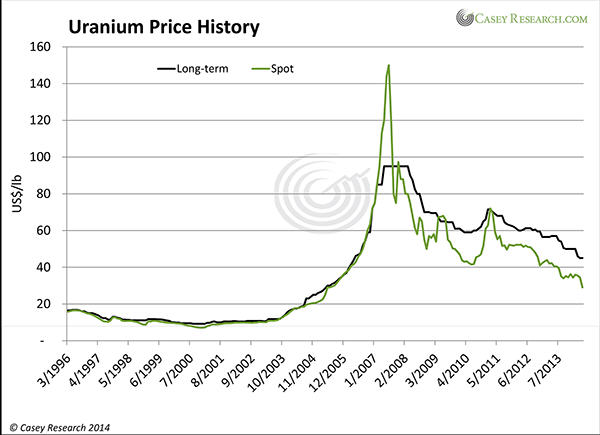The Uranium Sector: A look into our crystal ball
In May, the spot price of uranium broke $30 per pound of U3O8, a psychological barrier that I predicted would get tested and yield. The last time uranium traded in this range was mid-2005. It was trading last year around $40 per pound.
I think the market is going to get weaker yet until at least late 2014—that’s why I tell my subscribers to get positioned in only the best exploration companies exposed to the uranium-rich Athabasca Basin and low-cost producers in North America. There’s another criterion that I look for in such a weak market: We want to be invested only in companies that can go 24 months without any financing requirements.

We’re staying away from all other uranium companies for the time being. Specifically, what we don’t want are companies trying to increase uranium production in this weak market. They’re just depleting their reserves in a desperate attempt to keep money flowing in. Not the strong financials we look for.
I’m quite excited about the opportunities I believe the market will provide in the coming months. Just remember that old adage about good things coming to those who wait. If you’re an energy investor, keep your powder dry and wait for major market weakness, which I believe is on its way.
My team and I have been putting all of the producers’ financials through the wringer, listening in on their conference calls, and poring through their public material, the news, and the perspectives of other analysts. Here are some further thoughts we’ve pulled together on what we believe will happen over the next 9-12 months in the uranium sector.
More Views and Predictions
1. Global Nuclear Restarts/Decreases
Most published analysts believe the Japanese will restart between 8 and 16 nuclear reactors by the end of the year. I don’t think that’ll happen. My prediction is much more conservative: 2-4 reactors. Best-case scenario: 8-12 reactors restarted and operating by 2016, and it will grow from then on.
Another aspect that most analysts have missed regarding Japan’s restarts is that these events themselves won’t be enough to get the price of uranium going higher. They’ll help, to be sure, but until the Japanese start enriching, the price will remain low for separative work units (SWUs).
(SWUs measure the amount of separation work necessary to enrich uranium—in other words, how much work is needed to raise the product’s concentration of U-235 from its natural 0.7% to the 3-5% that most reactors require for fission.)
Meanwhile, the Russians with their stockpiles of depleted uranium tails will have a strategic advantage in underfeeding.
2. Weak SWUs = Underfeeding = More Uranium Production for Less
We believe that companies such as the private Dutch enricher Urenco have vastly increased their ability to produce uranium because of the current low cost of SWUs. If Urenco can more than triple its production from 1.5 million pounds to at least 4.5 million pounds (and it provides transparent financial reports on its website), then it’s not hard to believe that the Russians can do the same.
The Russians were able to produce about 5 million pounds last year, and we think in the current weak SWU market, they could triple that number with little extra cost. They can probably still make money at a uranium spot price as low as $22.50 per pound.
Nobody has yet talked about how Urenco, the Russians, or the other enrichers have responded to the weaker SWU price. They’re all producing more natural uranium (feed) in addition to existing enrichment services. This trend will continue until SWUs become more expensive.
Currently, about 150 million pounds of uranium are produced globally every year from mining operations. Without Japan and the Germans, current global demand is around 170 million pounds. The 20-million-pound gap is filled by secondary uranium supply—the processing of tails, decommissioned nuclear warheads, and so on.
In turn, secondary supply is filled by the transitional agreement (which has replaced the expired “Megatons for Megawatts” program for the short term)—and by the increased uranium production due to underfeeding by the Russians and other enrichers.
In short, there’s much more secondary supply available than the market is factoring in or knows about. Others will figure it out eventually, but meanwhile, you’re among the first to know.
3. Government Stupidity, Part I: France’s Nuclear Future
The socialist government of France is considering reducing the amount of electricity from nuclear reactors from the present level of about 75% to 50% by 2025. Granted, Fukushima showed the value of diversity in energy supply, but the proposed drop is a big one for such a short timeframe. With few natural resources, France will have to replace that electricity with Russian gas.
While the rollback is still in preliminary discussions within the government, expect the unexpected from government stupidity.
4. Government Stupidity, Part II: US Energy Information Administration (EIA) Numbers
The EIA came out with its annual outlook recently, and it expects some 6,000 megawatts-equivalent (MWe) of nuclear shutdowns on the horizon, in addition to the 4,800 MWe (five reactors) already accounted for.
I’ve pointed out the errors the EIA makes in its annual outlooks before, but the impact of the EIA statements will be felt in the nuclear sector.
5. Government Stupidity, Part III: DOE Uranium Sales
We were the first to mention the changes to the DOE uranium sales in the Casey Energy Report. The DOE needs to come up with $250 million a year for clean-ups. Expect governments to make the worst decisions, so the DOE will likely continue selling uranium into the spot market in 2014—even though they’re selling for cheap into a buyer’s market—and the sales will exert a further downward push on prices.
I expect the Obama administration to unload anywhere from five to eight million pounds.
6. Impact of China’s Plans
China plans on quadrupling the amount of the electricity generated from nuclear power. As with all major projects, there will be delays, but China has embraced nuclear energy as part of its new environmental plan toward clean baseload energy.
It’s no reach to say that China will be a major market for uranium producers moving forward, but it may surprise you how major. The country consumed nine million pounds of uranium in 2013, but produced only 3.3 million pounds.
That’s a big gap, and it’s only going to get bigger. By 2030, it’s expected that China will consume at least 50 million pounds of uranium, an amount that will exceed the current #1 consumer in the world, the United States.
7. Kazakhstan, the Wildcard
We’ve read a number of reports that predict production in Kazakhstan will decrease in the current weak market. I disagree.
Here’s my top reason: Roughly 10,000 jobs in Kazakhstan depend directly on uranium mining, which accounts for just under 40% of the world’s production. I think that keeping those people employed is more important to President Nazarbayev than the industry’s profit margin.
Kazakhstan’s production level of 58 million pounds can break even at current uranium prices, but if the government has to take a loss to maintain employment, I think it will, at least for a while.
The Cure for Low Prices Is Low Prices
Very little new uranium production is coming online at current low prices. The smart producers with the right financial and business acumen have cut costs and cut back production rather than depleting their reserves in the current environment.
That’s why we’re so bullish about the two uranium producers we have in our Casey Energy Report portfolio. One of them was the first uranium producer to start slashing costs and decreasing production, in September of 2013. The other one followed shortly after. Producers trying to grow production now, when prices for their product are so low, are foolish. They’re robbing Peter to pay Paul and will eventually be in a very difficult position.
With over 90 nuclear reactors currently under construction, the consensus is that global demand will rise to some 240 million pounds of uranium by 2024. Our models indicate that 170 million pounds of production can come online within five years if the spot price is at or above $45 per pound. At $55 per pound, that figure would rise to 190 million pounds.
The 50-plus-million-pound gap ensures that there’s a good amount of room—and thus market incentive—for primary production to grow. The benefactors of this huge growth in uranium demand will be those producers that can accomplish two things:
- Survive the next two years without going bankrupt. (We believe many uranium companies are on the brink of bankruptcy already.)
- Bring low-cost production online quickly. This means they’re moving forward with permitting and building during this weak market, so they can sprint out of the starting gate when conditions are favorable.
Thus, I see bullish factors entering the market, even though I also see it taking a few years for the spot price to wrestle its way back up to $55 per pound.
Marin Katusa, chief energy investment strategist.
{{ commodity.name }}
{{ post.title }}
{{ post.date }}

Comments